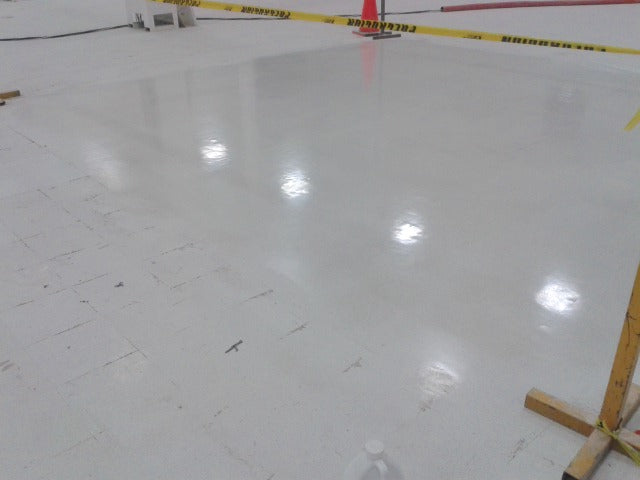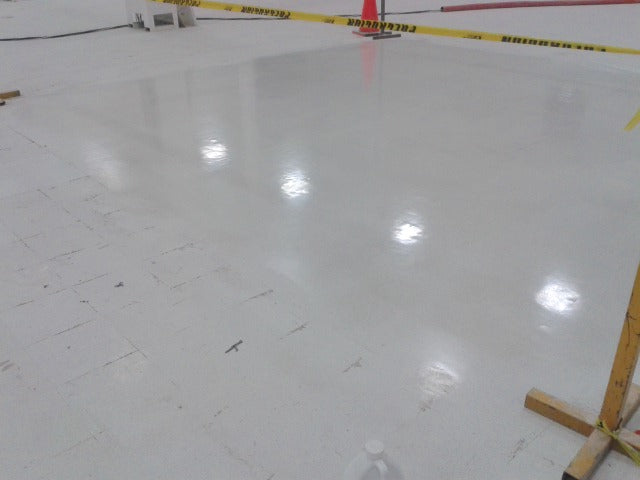How to Create a Maintenance Plan for Your ESD Floor
When people walk, friction between their shoe soles and the floor generates a static charge. In a critical environment workplace, if a charged person touches sensitive electronics, the sudden transfer of electrical current – called a random ESD event - can damage the component, causing problems ranging from electrical interference to lost or dropped critical/PSAP calls, GPS malfunction, explosions or product failure.
Electrostatic Discharge (ESD) floors are designed to prevent static electricity from building on people, protecting your sensitive electronics from random ESD events.
For an ESD floor to properly eliminate static, it must be cleaned and maintained.
Creating a Maintenance Plan for Your ESD Floor
- Understand the requirements of your ESD floor
- Establish a regular cleaning schedule
- Be sure to use the right cleaning products and tools
- Control foot traffic
- Conduct regular inspections
- Train employees on best practices for maintaining your ESD floor
- Test your floor in both high and low traffic areas
Why Do You Need a Maintenance Plan?
ESD floors contain conductive particles or elements that draw static away from shoe soles and discharge static charges to ground. When a floor is not routinely maintained, dirt and debris naturally accumulate on its surface. When dirt and debris accumulate on an ESD floor, this layer of dirt/debris acts as an insulator, physically blocking contact between shoe soles and the conductive elements in the floor.
When there is only partial contact or no contact between shoes/people and the floor, even the best ESD floor cannot discharge static to ground. Charges will build on people as they walk, putting sensitive components at risk. Depending upon the type of dirt and debris, the contaminants themselves may generate static.
This is why, for your ESD floor to perform as intended and protect your electronic equipment, it’s crucial to establish and follow a routine maintenance plan.
Here are 7 steps for creating an effective maintenance plan for your ESD floor:
1. Understand the requirements of your ESD floor
The first step in creating a maintenance plan for your ESD floor is to understand its requirements. Check the manufacturer's instructions and specifications to ensure that you are aware of the specific procedures and requirements for maintaining your ESD floor. ESD floors should never be waxed with a regular, non-ESD wax, for example.
2. Set up a regular cleaning schedule
To keep your ESD floor functioning properly, it is important to establish a regular cleaning schedule. This should include daily, weekly, and monthly cleaning tasks. Daily cleaning may include sweeping or dry mopping, while weekly cleaning may involve wet mopping or scrubbing. Monthly cleaning may require deep cleaning to remove any buildup of dirt or debris.
How often these tasks should be performed will depend upon your/your company’s aesthetic preferences (how clean you expect the floor to be); environmental factors, such as dust, dirt and chemical spills; and the type and amount of traffic – e.g. foot traffic or machinery, routine or occasional.
3. Be sure you have the right cleaning tools and products
When cleaning your ESD floor, it is important to use the right tools and products. Avoid harsh chemicals, abrasives or stiff-brushes or pads that could damage the floor. Instead, use a neutral pH cleaner, such as StaticWorx ScrubWorx and mop, or if the cleaner requires one a soft-bristled brush, to clean the floor.To clean heavy soiling, to remove built-up acrylic finishes or to restore an ESD floor to like-new condition, use a low foaming cleaner/degreaser like StaticWorx EcoScrub, followed by the application of a semi-gloss sealant like Formula 20.20 or a high-gloss static-dissipative finish like StaticWorx CoatZF.
4. Control foot traffic
To reduce the buildup of dirt and debris on your ESD floor, redirect and eliminate dirty foot traffic – coming directly from the parking lot to your workspace. Place walk-off and tacky mats at the entrance of the ESD-protected area to trap and remove dirt and moisture from shoes. Or consider installing shoe cleaners or requiring people to change into ESD shoes – before entering the work area.
- In electronics manufacturing and handling (SMT) spaces, the ANSI/ESD S20.20 standard requires every person on the floor to wear special ESD-protective footwear. Without the use of ESD footwear, certain flooring materials, particularly ESD vinyl and epoxy, will not perform properly and can actually generate static.
5. Conduct regular inspections
Regular inspections of your ESD floor can help identify any damaged areas or areas that require additional maintenance. Check for signs of wear, cracks, or other damage that may require repair. Check, too, for chemical spills, which can damage some flooring materials, and dust, dirt and debris that can create static and insulate shoe soles from the floor’s conductive surface, preventing your ESD floor from dissipating static charges to ground.
6. Train employees
Proper maintenance of your ESD floor requires the cooperation of employees. Train your staff on the importance of maintaining the ESD floor and be sure your maintenance/janitorial crew are aware of maintenance requirements, know which products to use on your ESD floor, and know how to properly clean and care for the floor.
7. Test your floor in both high and low traffic areas
The electrical resistance/conductivity of a floor may be different in a high traffic area covered with dirt and debris than it is in a low traffic area. A floor in a high-usage area may also be subject to chemical spills. These types of situations may require additional cleaning or a different cleaning procedure.
A floor that is not inherently conductive – i.e., relies on topical coatings for conductivity – can lose its ESD-protective properties over time. When topical wax or coatings wear off, the floor is of little to no use in preventing ESD events. Unless you test the floor regularly you have no way of knowing whether or not the conductivity has worn off or if it is performing properly.
By following these seven easy steps, you can create an effective maintenance plan for your ESD floor. A well-planned and executed program will keep your ESD floor looking great and ensure its long-term effectiveness. A clean, properly performing ESD floor will protect your sensitive electronic equipment for years to come.
Link to share
Use this link to share the article with a friend.



